The Good Old Days… When Everything Was White
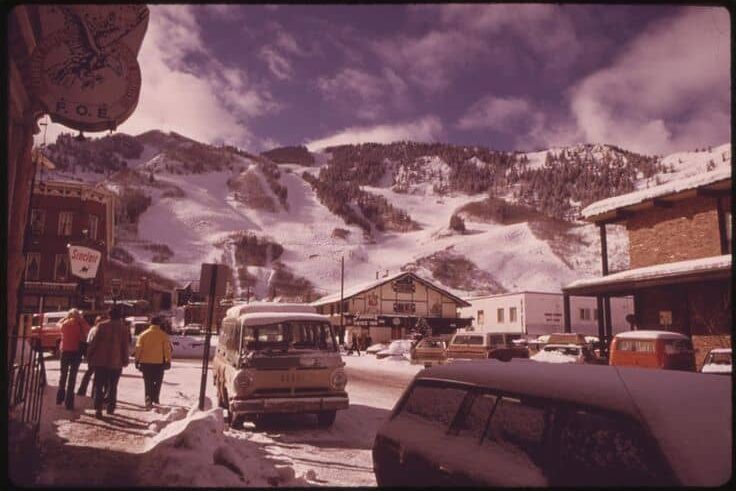
There’s nothing quite like the memory of a 1970s snow day. It was a time when a simple weather forecast held the power to transform a routine Tuesday into an unexpected holiday filled with the magic of deep snow and the comfort of a warm home. Step back in time and recall the pure, unadulterated joy of those winter escapes.
1. The Radio Decided Your Fate
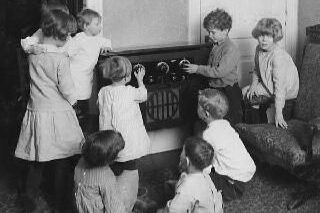
Before the internet and text alerts, your fate rested in the hands of the AM radio announcer. Kids would sit cross-legged by the kitchen or living room radio, listening with a blend of dread and anticipation as the announcer slowly read the list of school closings, usually in alphabetical order. The tension was palpable; if your district had a name near the end of the alphabet, the wait felt agonizingly long. When the words “[Your School District Name] is closed” finally broke the silence, it was the sound of sweet, instantaneous freedom. The moment was a collective, silent cheer that meant no homework, no school bus, and a whole day stretching out wide open for adventure, it felt like a sudden, unexpected win of the childhood lottery.
2. TV Crawls Were Rare but Magical
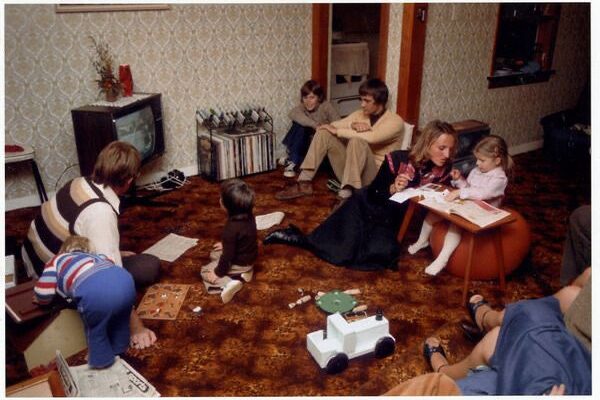
While the radio was the primary source, some local television stations provided a more visual confirmation, usually by scrolling the list of closings slowly across the bottom of the screen. These TV crawls were a novelty and added a layer of official magic to the day’s events. Families would gather, often squinting, waiting for their town or school to finally appear on the slowly moving banner. When the name popped up, often in large block letters, cheers would erupt in living rooms across America, cementing the snow day as a universally recognized, official holiday. This early form of broadcasting news gave a visual certainty that the radio sometimes lacked, truly making the snow day official in the warm glow of the television set.
3. Parents Verified with Phone Trees
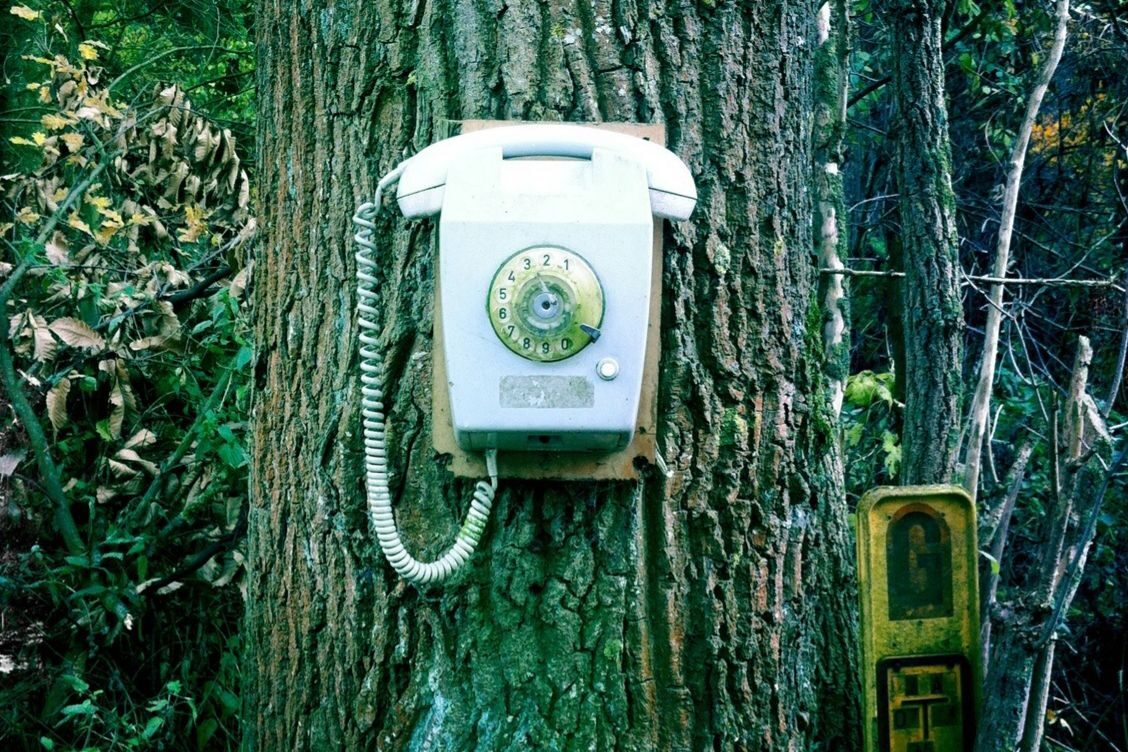
In an effort to speed up communication and ensure everyone got the news, PTA and neighborhood phone trees were an essential part of the 1970s snow day ecosystem. This system relied on a chain of moms calling each other to confirm the official closures, often spreading the news faster than the media. A ringing phone at 6:00 a.m. wasn’t usually an alarm; it was a hopeful signal. If the neighbor’s voice on the other end delivered the sweet words, “The schools are closed!” it was the final, human confirmation. This network was a testament to community organization, showing how parents worked together to ensure their kids got the official word, turning a small ring into a major announcement.
4. Pajamas Lasted All Morning
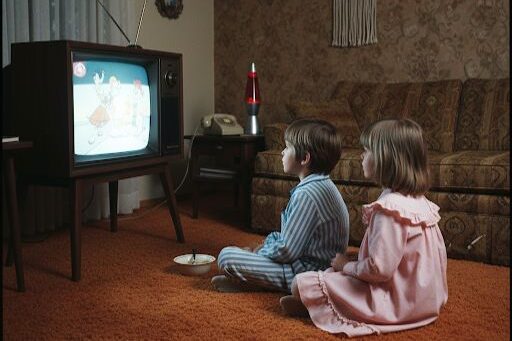
One of the deepest comforts of a snow day was the simple luxury of not having to rush to get dressed. With no alarm clock to beat, kids often lounged in their pajamas until noon or even later. Cereal bowls clinked softly, cartoons played on the TV, and the day stretched out ahead, boundless and open. This extended pajama-time wasn’t about being lazy; it was the first, cozy taste of a sudden, unplanned holiday. Staying in warm, familiar clothes until late morning was a symbolic act of freedom, marking a clear division between the stressful, structured life of a school day and the relaxed, easy-going flow of a winter reprieve.
5. The World Outside Looked Magical
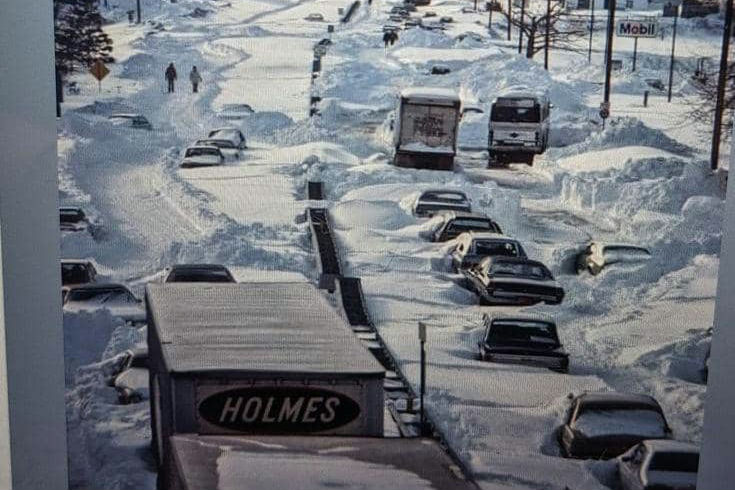
The moment you looked out the window on a heavy snow day, the familiar world was transformed. A thick, pristine blanket of white covered everything, muffling the usual sounds of cars, neighbors, and traffic into a profound silence. Trees bent under the weight of the heavy snow, their branches suddenly delicate and white, and cars seemed to shrink beneath the drifts. Stepping outside, the snow crunched loud and crisp underfoot, the only sound breaking the serene quiet. This shift turned an ordinary street into a stunning, temporary wonderland, making the familiar feel suddenly new, mysterious, and perfect for exploration.
6. Layering Up Was an Ordeal
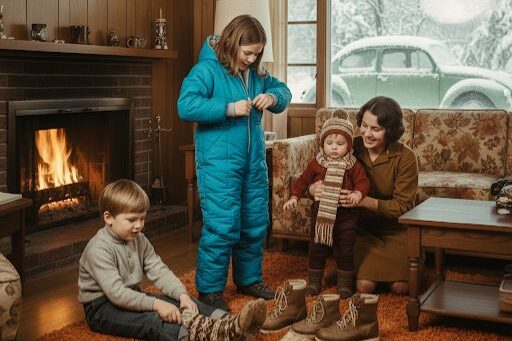
Before specialized synthetic cold-weather gear, the process of getting ready to go outside was an arduous, multi-step ordeal. It involved struggling into thick thermal underwear, pulling on heavy knit socks, zipping up cumbersome snowsuits, and finally adding scarves, hats, and boots. Zippers would often jam, mittens were constantly mismatched, and the sheer effort of pulling heavy rubber boots over pant legs could make a child sweat profusely. By the time kids were fully bundled and waddling to the door, they were often overheated, red-faced, and practically encased in so many layers that their movement was severely restricted.
7. Mittens Never Kept Hands Dry
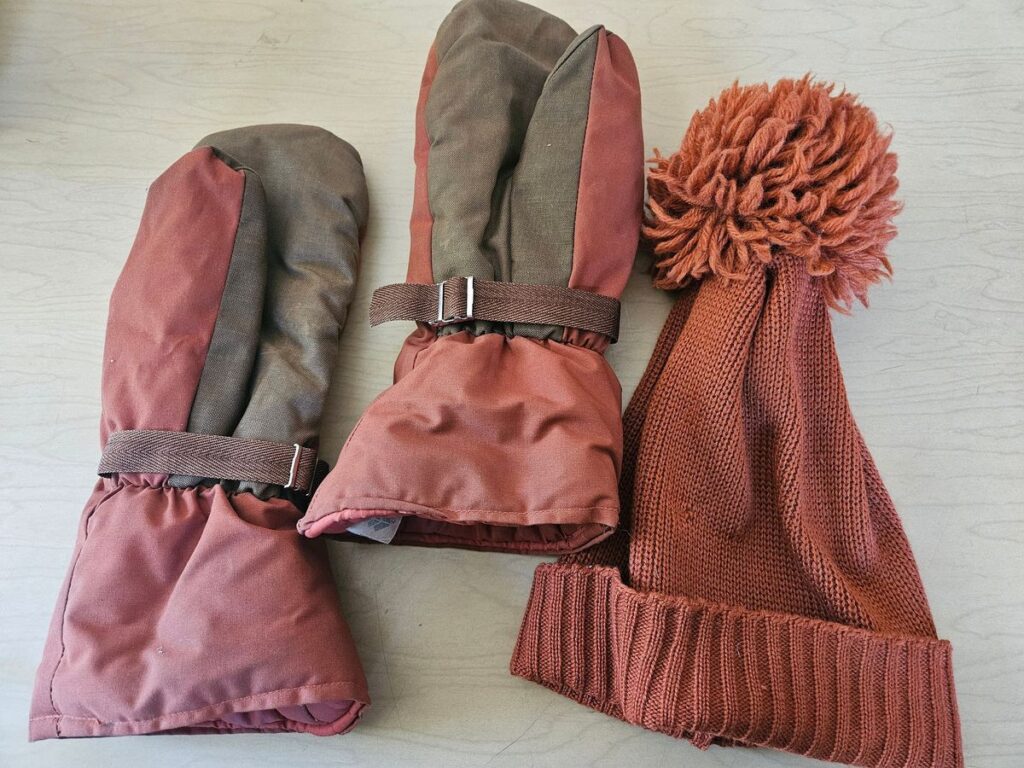
The wool or simple knit mittens common in the 1970s were notoriously poor at repelling moisture. They soaked up snow and ice like a sponge, leading to hands that went numb with cold in a shockingly short amount of time. Even the plastic-coated varieties were prone to split seams, leading to the same result. The immediate aftermath was a house full of damp, soggy wool: wet mittens were peeled off, tossed onto radiators or vents, and began to steam up the windows and fill the house with the heavy, distinctive smell of drying, damp wool that became the iconic scent of a snow day afternoon.
8. Scarves Wrapped Like Armor
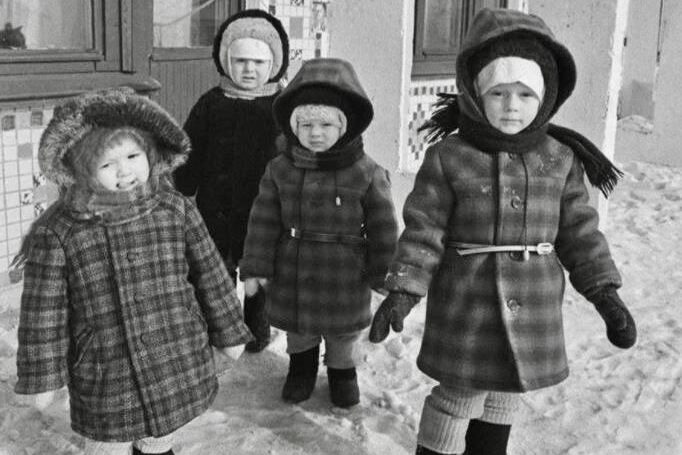
The mothers of the ’70s often treated a scarf like a piece of essential cold-weather armor, winding it tightly around their children’s necks, faces, and sometimes the entire lower half of their heads. The goal was to leave only the eyes peeking out from the thick knit fabric. Breathing through the scarf quickly turned the fabric into a piece of stiff, icy material that stung the skin. While functional, these tight wrappings often restricted movement and added to the already bulky feeling of the layers. Kids trudged into the biting cold so thoroughly bundled they looked like tiny, brightly colored mummies, often needing help to undo the knots when they returned home.
9. Sledding Hills Became Neighborhood Arenas
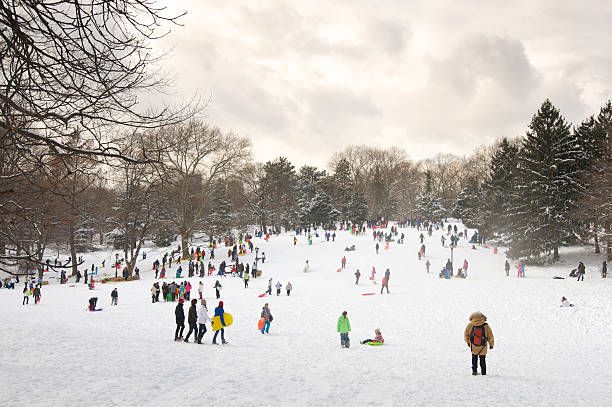
Every neighborhood had one, a local spot, usually a park slope or a rarely used small hill, that became the epicenter of all snow day activity. These hills had to be steep enough to provide a thrilling ride but generally safe enough to handle a large crowd of unsupervised kids. Children lined up at the top, dragging their sleds of all shapes and sizes, and the air filled with the chaotic, joyful sounds of laughter, the whoosh of sleds speeding down, and the loud crunch and squeak of the snow as feet dragged to brake. The “neighborhood arena” was a free-for-all of speed and spills, where everyone was united by the shared, simple goal of flying down a hill.
10. Flexible Flyers Were the Gold Standard
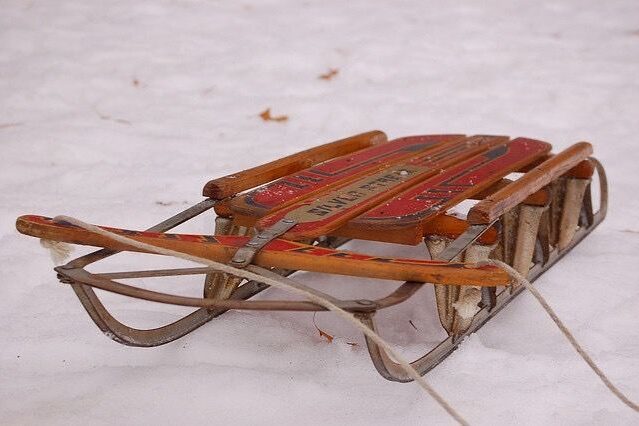
Among the various sledding options, the Flexible Flyer, a classic wooden sled with runners and a distinct red steering bar, was the undisputed king. These sleds were fast, offered a semblance of control throÁugh their steering, and felt like the snow-day equivalent of a racecar. Kids would fly down the steepest slopes, often headfirst for maximum speed, attempting to steer by dragging their boots in the snow or maneuvering the bar. The inevitable collisions with trees, snowbanks, or other sleds were simply part of the thrill, and coming home with a few bruises or scraped knees from a glorious wipeout was considered a badge of honor earned on the hill.
11. Anything Became a Sled in a Pinch
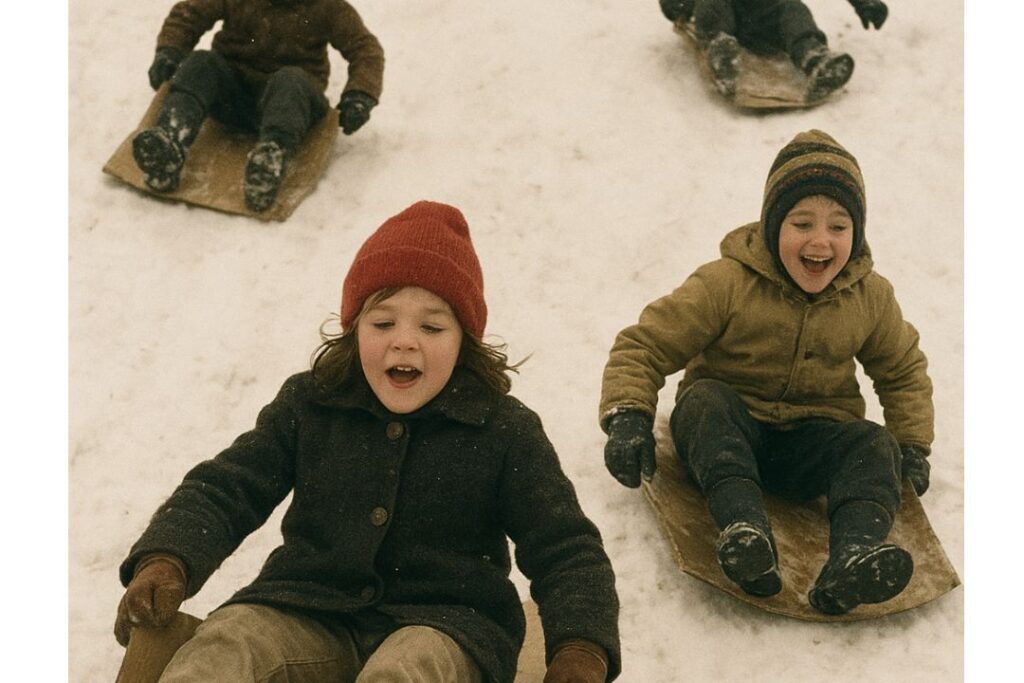
When the official sleds, the Flexible Flyers or metal saucers, were claimed or the crowd was too large, 1970s kids became masters of snow day improvisation. The rule was simple: if you could sit on it and it slid, it was a sled. This led to wonderfully chaotic scenes on the hills involving everything from metal garbage can lids (which spun wildly), to discarded cardboard boxes (which were fast but short-lived), and sometimes even stolen cafeteria trays. The improvised rides often led to more frequent crashes, hilarious spills, and the loud, echoing clang of makeshift equipment hitting the packed snow, proving that determination and a simple object could be just as fun as the most expensive toy.
12. Snowball Fights Escalated Quickly
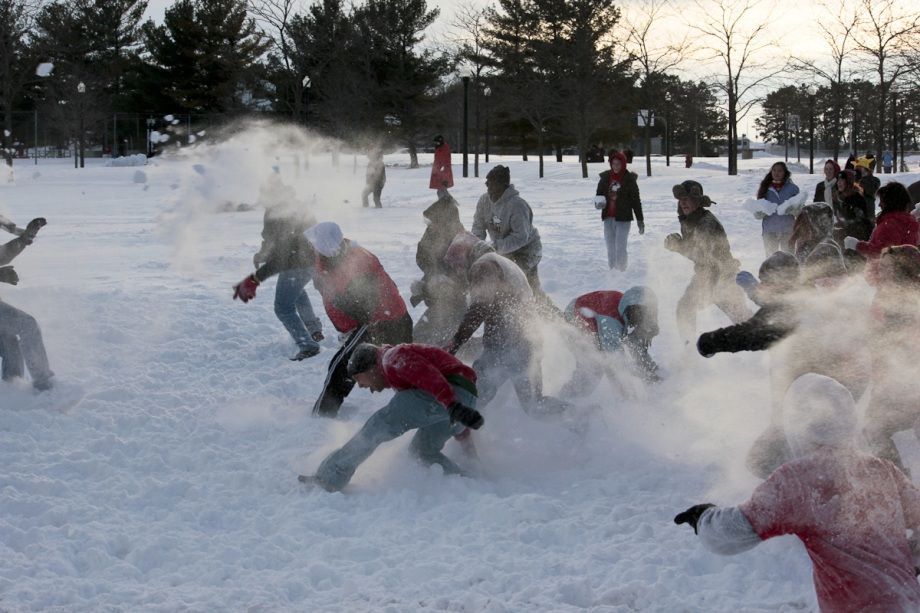
What usually began with a few playful, tossed handfuls of snow often rapidly turned into full-scale neighborhood battles. These were serious, organized affairs: kids would spend hours packing snow into sturdy, icy forts and walls, setting up elaborate ambushes behind drifts, and forming temporary, shifting alliances. The focus was on stealth, strategy, and having a ready supply of well-packed snowballs. A perfectly thrown, densely packed snowball could leave a stinging mark, a temporary price of war. These large-scale “snow wars” left the participants breathless, soaked, and undeniably victorious, even if their teams ultimately lost the last flag or fort.
13. Building Snowmen Filled Whole Afternoons
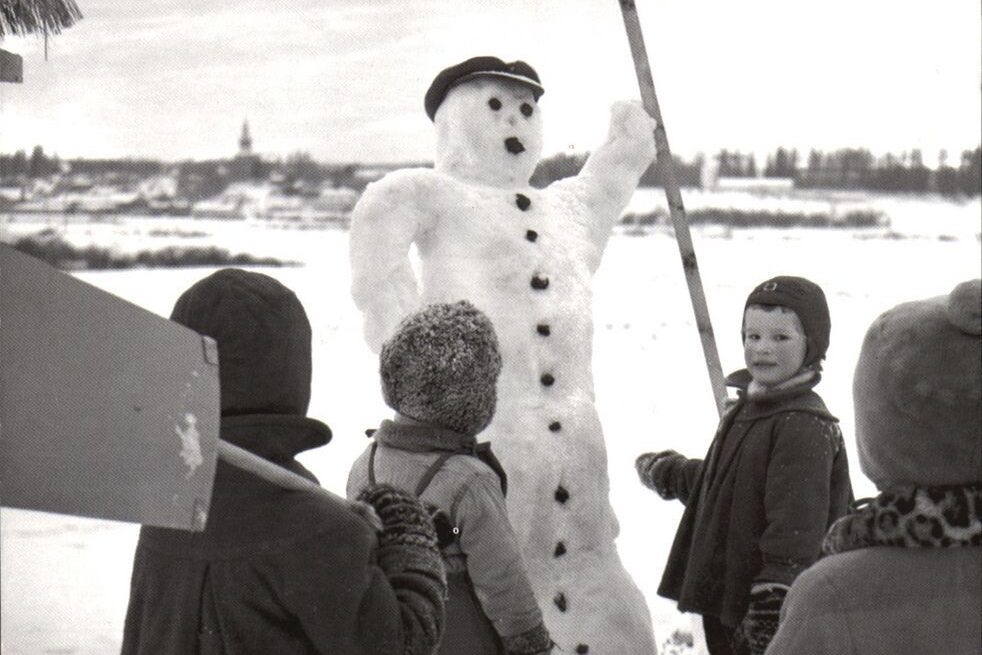
The iconic snowman was an essential architectural project of every snow day, often filling the quieter hours of the late afternoon. This classic activity was a test of both strength and creativity. Kids would begin by rolling small snowballs and pushing them across the yard until they became giant, heavy bases. After the difficult work of stacking the three heavy tiers, the true artistry began: decorating. Carrots were reserved for the noses, coal or buttons for the eyes and smile, and a family scarf was often borrowed for the neck. Each snowman, some leaning precariously, others standing proudly, became a unique, temporary landmark and a proud testament to the teamwork and shared imagination of the neighborhood kids.
14. Igloos and Forts Tested Determination
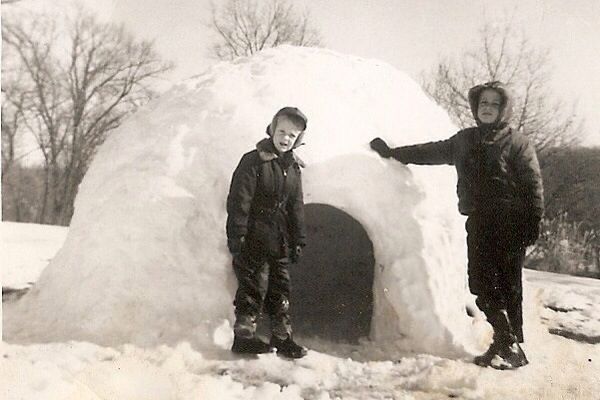
More ambitious builders turned their efforts toward creating igloos, tunnels, and snow forts that required serious determination and hours of hard work. Digging and carving out livable spaces from large snow piles felt like true engineering feats. Children would pack snow tightly, sometimes using tools like shovels or even bare hands, to create walls and roofs just sturdy enough to crawl inside. Once constructed, these icy castles became private, imaginary domains where kids pretended they were explorers or living in a frozen kingdom. The pain of frozen, stiff fingers was easily ignored as long as the work continued and the warm, bright glow of imagination sustained the effort.
15. Frozen Cheeks Glowed Cherry Red
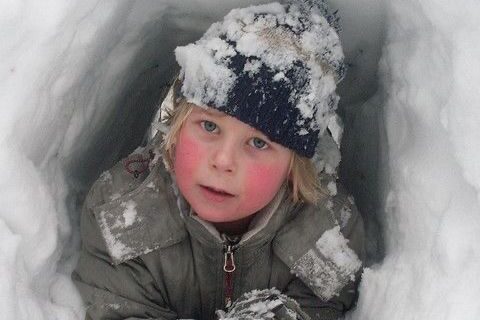
After spending hours immersed in outdoor play, a child’s face was an unmistakable map of the cold: cheeks would be a vibrant, stinging cherry red, noses were perpetually running, and ears often had a painful burning sensation. Kids routinely ignored all these physical signals, only heading indoors when a parent’s insistent call finally broke through the fun. Once inside, the process of thawing out was a unique mix of agony and relief. Placing numb, stiff fingers under a stream of warm water was a memorable pain that signaled the end of the day’s outdoor adventure and the beginning of the indoor comfort.
16. Hot Chocolate Was the Ultimate Reward
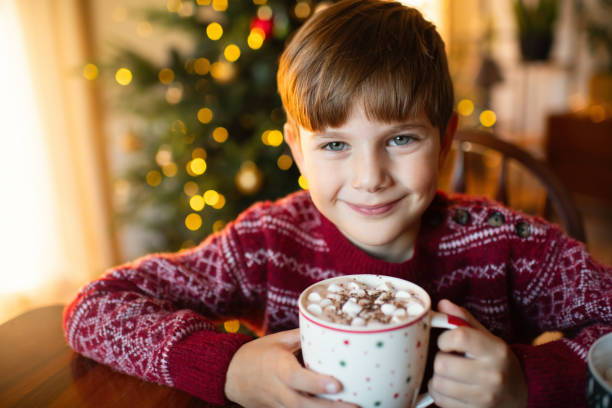
The end of a long, cold day of outdoor play was always signaled by the ultimate, non-negotiable reward: a steaming mug of hot chocolate. The rich, warm cocoa, sometimes topped with a few miniature marshmallows, was more than just a drink; it was a deeply comforting ritual. Wrapped in thick blankets, kids would cup the warm mugs, feeling the heat seep into their numb hands and sipping slowly as the warmth spread through their chilled bodies. This sweet, rich beverage was the victory fuel of the snow day, a perfect, sweet ending to the day’s epic adventures.
17. Soups and Grilled Cheese Filled Kitchens

The simple, classic meal of a 1970s snow day was tomato soup and grilled cheese sandwiches. The savory aroma of tomato soup bubbling softly on the stovetop mixed with the sound of butter and bread crisping in a hot pan. This lunch or dinner, eaten after a full day of sledding and snowball fights, felt heartier and more intensely delicious than any meal on an ordinary school day. The warmth of the soup and the familiar, satisfying crunch of the buttered sandwich became an integral part of the snow day experience, making the day as much about simple, warm comfort food as it was about outdoor fun.
18. Windows Frosted with Patterns
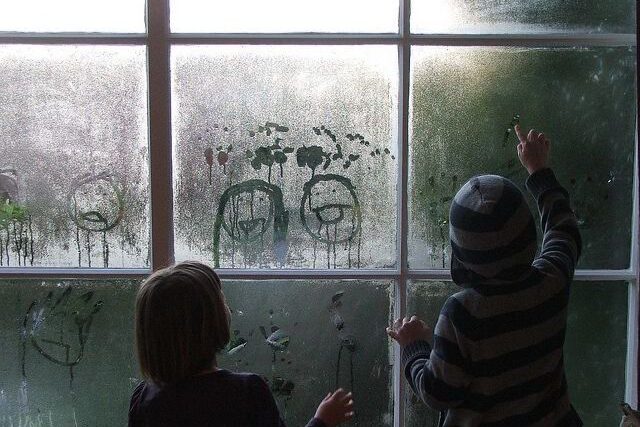
Older homes, often with less efficient single-pane windows, provided a beautiful side effect to the cold: intricate frost patterns that grew like delicate lace across the glass. These icy formations turned the windows into temporary, natural artwork. Kids would press their noses to the panes, fascinated by the detailed crystalline shapes, sometimes drawing simple pictures or writing their names with their fingertips, instantly melting the frost. The outside world, viewed through this icy filter, looked serene and distant, making the inside feel incredibly safe, warm, and cozy, a small, glowing haven against the winter’s chill.
19. Board Games Came Out of Closets
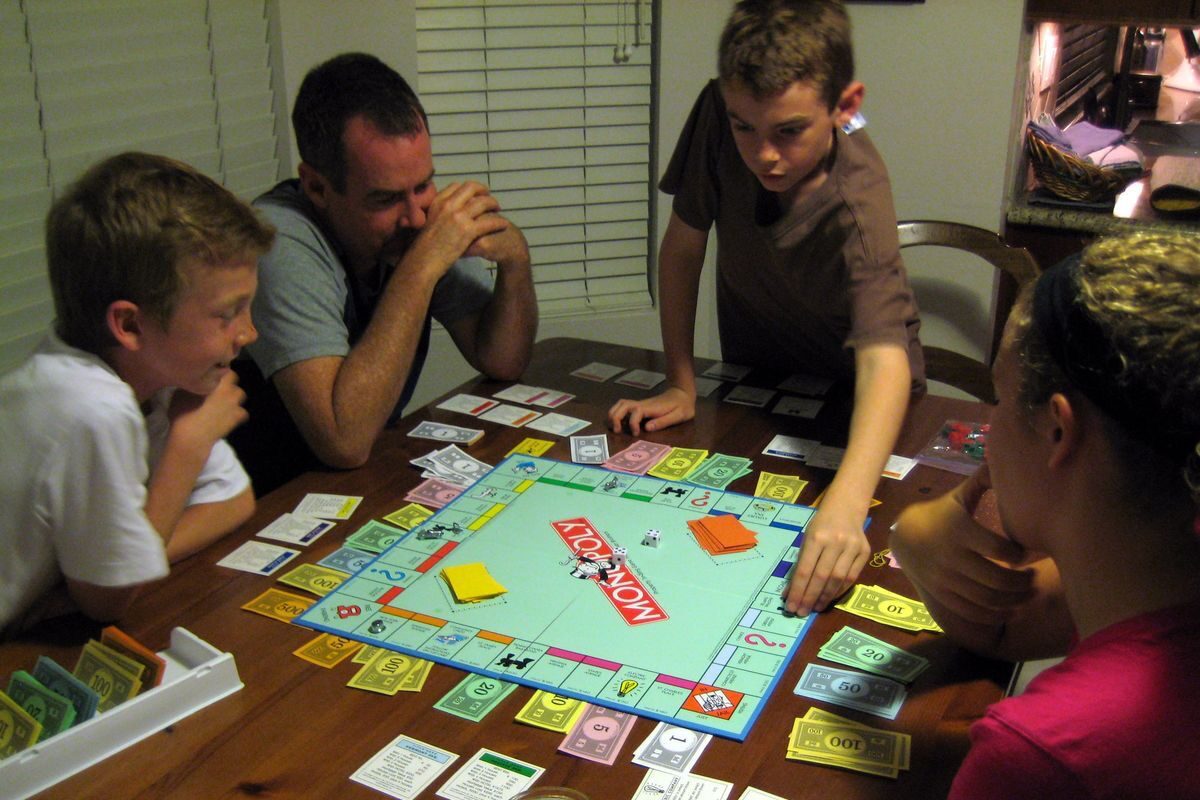
When the cold kept families trapped indoors, the big board games were enthusiastically pulled from the back of closets and shelves. Classic games like Monopoly, Life, and Sorry often ended up spread across the kitchen table or the living room floor. Dice rolled constantly, light-hearted arguments flared up over rules, and games could stretch on for hours, transforming the unexpected day off into a marathon of competitive fun. Snow days weren’t solely about outdoor adventure; they were also about creating intense, shared, and memorable indoor family time, turning a day of being snowed-in into a day of genuine connection.
20. TV Felt Different During the Day
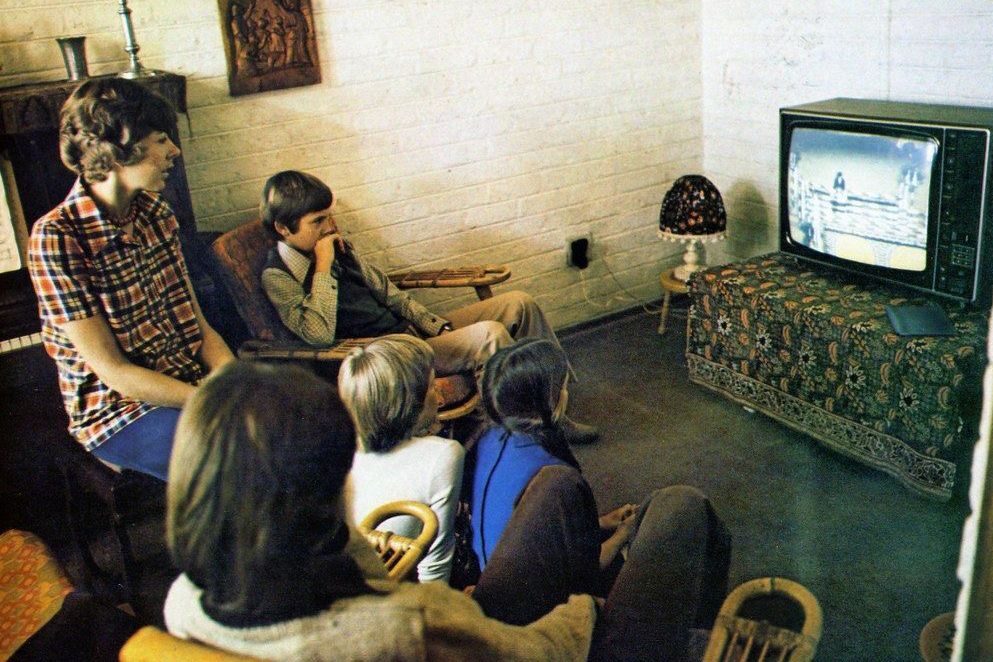
One of the great pleasures of a snow day was the simple act of watching television during hours you were normally supposed to be at school. This illicit pleasure gave even the most mundane programming, from mid-morning cartoons and talk shows to afternoon reruns, a special, thrilling glow. It created the feeling of having successfully gotten away with something. The day turned into a continuous, unplanned television feast, where the normal rules of media consumption were suspended, and every program watched felt like a small, private victory over the strict structure of the school week.
21. Radios Carried Storm Updates
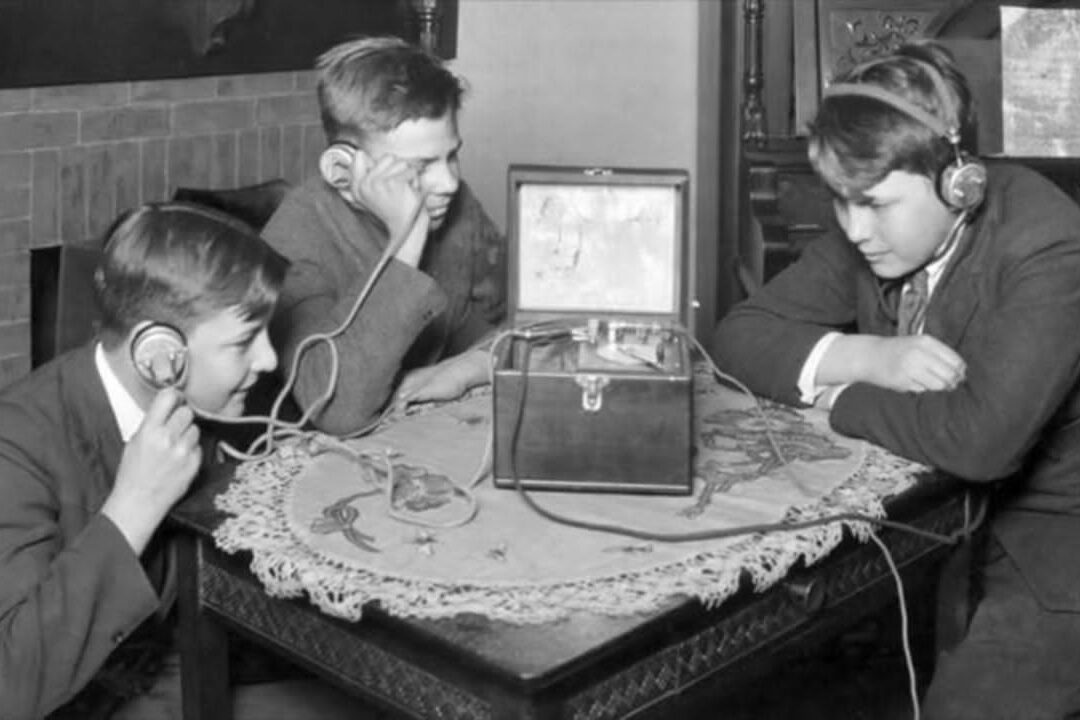
While kids focused primarily on the closing list, the radio stations continued to broadcast important storm updates throughout the day. Announcers provided warnings about worsening road conditions, predicted more snow accumulation, and advised caution for anyone who had to drive. Children would listen, but only with half an ear, knowing that for them, the only essential statistic was that the schools remained closed. For a child, the severity of the storm was secondary to its effect on the school schedule: as long as the snow was heavy enough to keep classes canceled, the winter storm was viewed not as a burden or inconvenience, but as an exciting, generous gift from nature.
22. Parents Worried While Kids Rejoiced
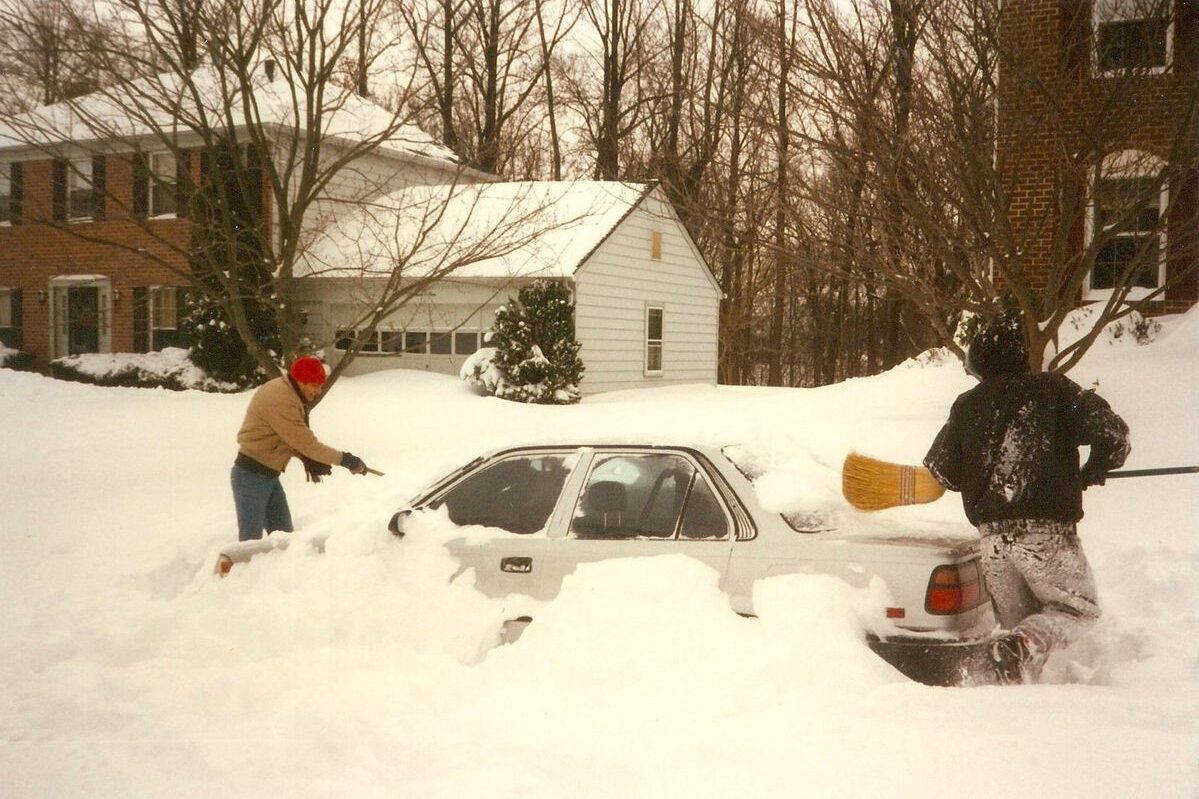
The same snow day that brought boundless joy to children often brought a distinct set of burdens and worries to their parents. Moms and dads had to quickly shift their schedules, often spending the morning shoveling heavy, wet snow off driveways and salting treacherous front steps. Many parents worried about their own work commutes, whether their offices would be open, or how they would manage their jobs while supervising energetic children stuck indoors. The snow day, therefore, offered a unique contrast, revealing the wide gap between the adult’s reality of practical stress and the child’s reality of pure, unadulterated wonder.
23. The Quiet at Night Was Profound
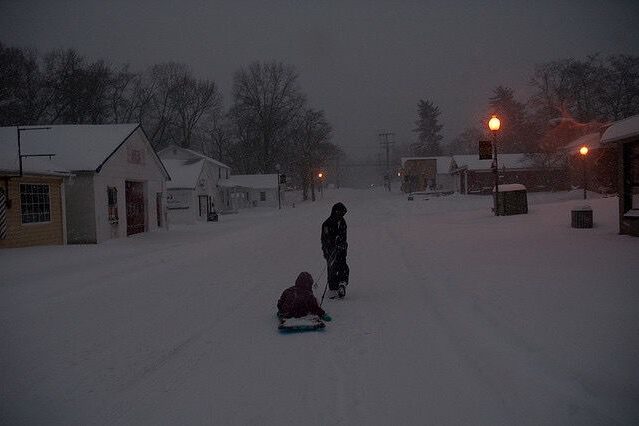
As the evening approached, the world outside fell into a deep, profound silence that only a fresh blanket of snow can create. The streetlights overhead seemed to glow with soft, hazy halos in the falling flakes, and any sound, a passing car, a distant bark, was quickly absorbed by the thick, insulating layer of white. Standing at a window, watching the soft snowfall under the light, children felt a unique sense of being small yet perfectly secure. It was a magical, hushed conclusion to the day, offering a peaceful, private moment to watch the world entirely wrapped in winter’s beautiful, temporary embrace.
24. Snow Days Weren’t Just Days Off, They Were Gifts
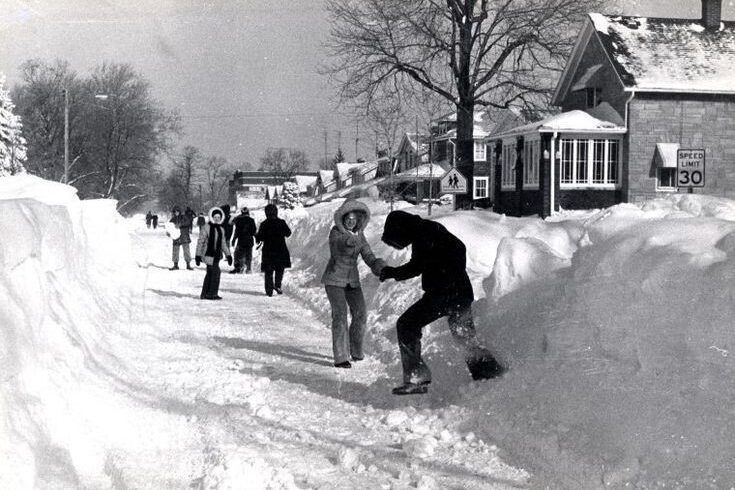
The 1970s snow day was far more than a simple cancellation of school. It was a complete, unexpected pause in the ordinary routine of life, a perfect storm of hot cocoa, flying sleds, glowing cheeks, and the comfortable mess of indoor board games. These were the days woven tightly into the tapestry of childhood memory: moments when the clock seemed to stop, the world hushed, and the sheer, unbridled joy of being a kid took over completely. They were rare, unearned gifts that imprinted themselves as vivid, warm memories of winter magic.
Do you remember racing to the kitchen to listen to the radio? Share your favorite memory of a 1970s snow day in the comments below!
This story 24 Memories of 1970s Snow Days was first published on Daily FETCH


